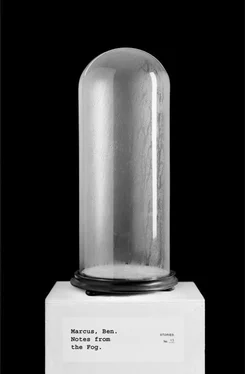It is hard to escape the feeling that this is a weakness of the project, no matter how profoundly ambitious it is to create a world, build things in it, and then allow life to bloom. It is a clear weakness to create an erratic, confusing experience out of time, to give each creature an apparently unique perception of time, and then to make time itself inconsistent, poorly designed, and finally simply too hard to believe. An unfortunate weakness in an otherwise intriguing project.
Moving inside, the hospital featured people bent over each other in postures of carnage. These exhibits did not expire, which makes it awkward to comment on them now. One must believe that nothing of interest will ever happen again in order to declare anything of substance now. The trick behind work like this is how foolish it makes you feel for trying to observe anything about it. To be invited to the exhibit, you had first to fall ill, then be carried there in an ambulance. Or you needed to apply for a job and then actually perform it, which guaranteed a bias that prevented lucid reflection on the hospital itself. To join the exhibit was to recuse yourself from a rational state. This would explain the long lines, the carefully constructed illness narratives, the displays of frailty. It is perhaps no accident that leaving one’s home is also called “joining the exhibit.”
Attention to detail on the island was staggering. An actual landscaping firm had been hired to produce what was probably considered actual landscaping. Grass and pavers, shrubbery patterned after a shield. From high above, the topography achieved a devastating insignia, most awful to behold, but no one was privileged to this view. As with many buildings, something unbearable was inferred. You didn’t need to see or even know about it. It was inferred, and that was certain.
The streets surrounding the hospital, themselves authentic in materials, were given actual names, and the names were ratified through constant use. Advanced surveillance revealed significant adoption of the streets, with a troubling degree of realism. Pedestrians questioned there showed no sign that they were aware of being part of the exhibit. In some ways, these pedestrians were perhaps the exhibit’s most striking feature, a clear sign of the new kind of work being done today. Certainly a trend can be observed in which the civilian members of an exhibit insist that they have arrived under their own power, pursuing tasks they are sure they thought of themselves. Very few of these civilians seem aware of their true purpose. Dissection revealed otherwise, of course. Dissection revealed a clear program carried out at what can only be called the cellular level.
Testing revealed that the inhabitants of the island came from all over the world. They had been born into different families, grown with food, sometimes managed by handlers, other times left alone. Some of them actually existed. No real pattern in their origins could be detected.
The doors to the hospital operate just as one imagines real doors should. Inside, a series of smaller exhibits takes shape as you approach them, then vanishes from view when you turn your back. This effect—objects vanishing if you are not looking at them—is ingenuous, and so easy to take for granted.
In one piece, set inside an authentic-looking room, a man in a doctor’s costume approaches the sickbed. This is not a painting. The man seems made of a soft, fleshy substance. You have this feeling, looking at him, of wanting to touch him, but not romantically. Actual vocal noises emerge from this piece. Heaps of cloth surround the sickbed, faces buried inside. These are ostensibly the loved ones of the patient, collapsed in postures, one must guess, of grief. The cloth would appear to be real cloth. It’s uncanny. Even the bed seems fabricated of actual material: steel, plastic, and cotton. One is impressed by the trouble such fealty must have taken. The hospital makes a mockery of convincingness. The hospital achieves believability so easily, with such facility, it seems to suggest that believability is a terrible criterion for our daily lives, one we would do well discarding, and yet everywhere throughout the hospital believability seems to be what matters most. Perhaps the hospital satirizes the idea of being alive. Certainly there is a critique, in this piece, of waking up, of bothering to live.
So much of the piece is well made, not in the classical sense, but in the brutal, violent sense. It looks as if it was made by skilled craftspeople at gunpoint. The hospital looks like it was built at gunpoint. The people inside the hospital look as if they were born at gunpoint. The hospital looks as though it was positioned on the island at gunpoint. Even the island, when one examines its undercarriage, when one swims its circumference, seems to have been assembled, piece by piece, at gunpoint, dropped from the sky at gunpoint, made to decay just as real things decay, at gunpoint. One looks at such a hospital at gunpoint, then one walks away at gunpoint, travels home and goes to bed at gunpoint, only to wake up years later with the same awful gun held to one’s head.
The hospital is deliberately made to outlast us, to still be standing when we’re gone. There is a clear critique of the ephemerality of people, the way they reliably perish. The hospital would seem to gloat; not in the personified sense. Can a piece like this be faulted for its desire to feel more lifelike than we do? One pleasing feature of the piece is that you can reach into the space surrounding the bed. You cannot touch the bed itself, for some reason. The bed is off-limits. But you can handle the space around the bed, digging your fingers into the cloth where the patient’s loved ones are hiding their faces. With practice and focus, you can feel the faces inside the cloth, and they seem to actually respond to your touch. One has one’s hand kissed. One feels tears against one’s palm.
Years later, as the piece ages, the room and the bed and the cloth are gone. We do not see them removed, they never appear to decay. But they do not survive the passage of time. What remains of the piece are the lifelike bodies—living bodies, one surmises—hovering in space. The floor is gone. What remains of the hospital is too little to remark on. It would seem that the entire hospital has been removed with surgical precision. The area where the hospital was is brighter than what surrounds it, as if a piece of furniture has been moved across a wood floor, exposing an unlived area just waiting to catch up to the rest of the world.
In the piece, the man who once wore the doctor’s costume but is now incomplete (“naked” would seem to be the wrong word, since he lacks finer detail) approaches the patient who, years ago, because of his bedclothes, was not visible whatsoever. Now we can see him and the effect is terrible. The patient’s loved ones, no longer hidden in cloth, but not naked either—unborn is how they also seem, their mouths unfinished, their hair not quite resolved—exist in a tangle on the side of the patient’s bed. The hospital and its host island are gone. The nearby island, tethered to a possible continent, is gone, and the extreme distance yields nothing to the observer. All that remains are the few people in what was once a room but is now nothing, even as these people begin to fade and soon leave just pale shapes, themselves dissolving slowly into nothing that can be named.
The hospital recalls a time when the entire world was referred to as Potter’s Island. A certain era is evoked when we lived on the graveyard. The hospital suggests that it is a myth that there are zones of earth in which bodies are not buried. It is a myth that some areas of the world are graveyards while some are not. One might accidentally, and infrequently, walk across a plot of earth in which, upon which, people have not been smeared away, hidden in soil once their time finished, but the chances are small. The chances may be nonexistent. The dead are beneath us, but the air contains the dead as well.
Читать дальше











